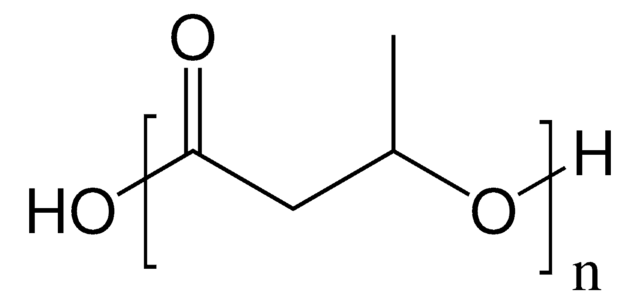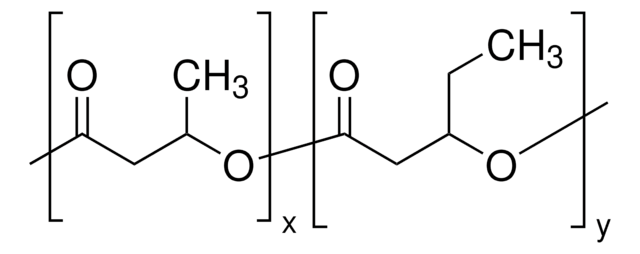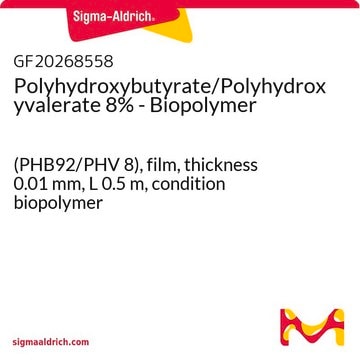Products may be shipped at a different temperature than the recommended long-term storage temperature. If the product quality is sensitive to short-term exposure to conditions other than the recommended long-term storage, it will be shipped on wet or dry-ice. If the product quality is NOT affected by short-term exposure to conditions other than the recommended long-term storage, it will be shipped at ambient temperature. As shipping routes are configured for minimum transit times, shipping at ambient temperature helps control shipping costs for our customers. For more information, please refer to the Storage and Transport Conditions document: https://www.sigmaaldrich.com/deepweb/assets/sigmaaldrich/marketing/global/documents/316/622/storage-transport-conditions-mk.pdf
363502
Poly[(R)-3-hydroxybutyric acid]
natural origin
Sinónimos:
(R)-3-Hydroxybutyric acid polymerized, PHB
About This Item
Productos recomendados
temperatura de transición
Tm 172 °C (DSC)
cadena SMILES
CC(O)CC(O)=O
InChI
1S/C12H20O6/c1-8(14)6-11(15)18-10(3)7-12(16)17-9(2)4-5-13/h5,8-10,14H,4,6-7H2,1-3H3
Clave InChI
QLACRIKFZRFWRU-UHFFFAOYSA-N
¿Está buscando productos similares? Visita Guía de comparación de productos
Categorías relacionadas
Descripción general
Aplicación
Código de clase de almacenamiento
11 - Combustible Solids
Clase de riesgo para el agua (WGK)
WGK 3
Punto de inflamabilidad (°F)
Not applicable
Punto de inflamabilidad (°C)
Not applicable
Elija entre una de las versiones más recientes:
¿Ya tiene este producto?
Encuentre la documentación para los productos que ha comprado recientemente en la Biblioteca de documentos.
-
How is shipping temperature determined? And how is it related to the product storage temperature?
1 answer-
Helpful?
-
-
How can I determine the shelf life / expiration / retest date of this product?
1 answer-
If this product has an expiration or retest date, it will be shown on the Certificate of Analysis (COA, CofA). If there is no retest or expiration date listed on the product's COA, we do not have suitable stability data to determine a shelf life. For these products, the only date on the COA will be the release date; a retest, expiration, or use-by-date will not be displayed.
For all products, we recommend handling per defined conditions as printed in our product literature and website product descriptions. We recommend that products should be routinely inspected by customers to ensure they perform as expected.
For products without retest or expiration dates, our standard warranty of 1 year from the date of shipment is applicable.
For more information, please refer to the Product Dating Information document: https://www.sigmaaldrich.com/deepweb/assets/sigmaaldrich/marketing/global/documents/449/386/product-dating-information-mk.pdfHelpful?
-
-
What is the organism from which PHB is extracted?
1 answer-
This product is manufactured by fermentation of cell culture. The exact organism is considered proprietary.
Helpful?
-
-
Do you know what the solubility of PHB in chloroform is?
1 answer-
The solubility of this product in chloroform has not been tested. However, historical data suggests that 5 parts PHB powder can be mixed with 95 parts chloroform in an explosion-proof pressure tube, sealed, and heated for a few minutes at 90°C.
Helpful?
-
-
We are using PHB and a standard for our HPLC method. This involves conversion to crotonic acid in boiling sulfuric acid. However, once cooled, crystals are formed. Any advice in how to deal with this?
1 answer-
Both PHB and crotonic acid are prone to crystallization from aqueous solutions. It is likely that the concentration of one or more of these solutes exceeds the saturation point in the solvent being used.
Using a lower concentration of PHB (either less PHB or more solvent) may inhibit the formation of crystals. Crystals recovered from the solution by filtration can be resolubilized using water, and this process can be expedited using sonication.
Helpful?
-
-
What is the molecular weight of this polymer?
1 answer-
The molecular weight of this material is not tested on a lot-to-lot basis. However, historical information suggests a molecular weight of approximately 400-500 kDa.
Helpful?
-
-
Do you have data about the purity of this sample of PHB?
1 answer-
Unfortunately, this product is not tested for purity.
Helpful?
-
Active Filters
Nuestro equipo de científicos tiene experiencia en todas las áreas de investigación: Ciencias de la vida, Ciencia de los materiales, Síntesis química, Cromatografía, Analítica y muchas otras.
Póngase en contacto con el Servicio técnico








